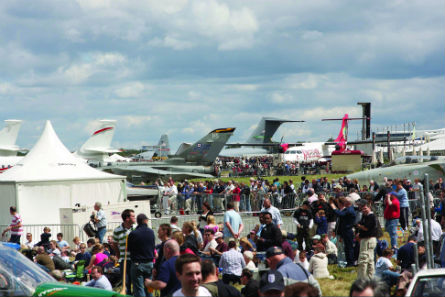To its knockers, the Farnborough air show has become an anachronism. The event, they say, remains anchored in an era when British brands ruled the skies at a time when UK manufacturers are mostly suppliers for aircraft assembled elsewhere.
And while the aviation marketplace is moving south and east - and being increasingly served by regional, sector-specific trade shows - Farnborough is an expensive, week-long, multi-sector affair, increasingly unsuited to the needs of modern global industry.
Critics also point to the absence of big names. Northrop Grumman will not be at Farnborough this time and Honeywell has failed to attend for several years. At a time of consolidation and shrinking marketing budgets, several other major players have substantially reduced their presence.
With Geneva's EBACE show firmly established, Farnborough fails to attract business aircraft manufacturers in any number. Furthermore, claim the detractors, the event seems torn between trying to be a focused business-to-business summit from Monday to Thursday and its weekend guise as a crowd-pleasing extravaganza, with spectacular, if noisy, air displays taking place each afternoon of the show.
The roar of a supersonic fighter silencing a crucial press conference or business discussion in one of the chalets perhaps highlights this dilemma. A distraction, say some. The sound of freedom, say others.
Add to that: high-season London hotel prices, stifling security, the UK's unpredictable July weather, and the traffic congestion en route to the show and within the site's narrow, tiered alleyways and you might wonder why anyone bothers to turn up to this pop-up city in a corner of Hampshire at all.
So why does Farnborough retain its status - with Paris - as one of the two big global air shows? Despite the success of rivals such as Dubai and Singapore, none has displaced the duopoly or managed to attract such a big and diverse audience. No attempt to launch a multi-sector show in the USA - which still has the biggest aerospace industry and marketplace in the world - has got off the ground.
 |
|---|
| Farnborough International |
This year's show will have some 1,400 exhibitors from 40 countries, and attract 250,000 trade and public visitors. Once again, organiser Farnborough International (FIL) - part of industry body ADS - has sold out chalet, static display and hall space. A total of $47 billion of orders were officially placed at the 2010 show. This year's total could surpass that.
One reason is tradition (the unkind might call it inertia): once a show is established as a must-attend for the industry's great and the good, it is difficult to knock it off its perch. It is the reason the Oscars are the Oscars and the Grand National remains the most popular fixture on the horse-racing calendar.
Another is location. Aside from a few personae non grata, Farnborough and the UK remain open to virtually all-comers. Israeli companies share the halls and chalet lines with those from the Arabian Gulf; Russian exhibitors and aircraft were welcome even during the Cold War. Groups of uniformed officers walking along the static will display the insignia of dozens of different air forces, not all of whose nations are on the best of terms.
A final factor is Farnborough's ability to adapt and innovate. Chief executive Shaun Ormrod, who joined in 2008, began a 12-year plan to develop the air show site, part of which involves securing a permanent exhibition area for key exhibitors in return for a long-term deal. One exhibitor which has taken FIL up on this is EADS, which has signed up for three shows where it will exhibit from a new pavilion on the flightline which integrates its chalet, stand and static display in one zone.
Other major groups have made similar moves, most notably Italy's Finmeccanica - which has signed until 2014 and whose large red-and-white structure has become a fixture at the past three shows in the area in front of the exhibition halls known as Finmeccanica corner. "Our vision is to provide the perfect arena for our clients," says Ormrod, "enabling them to consolidate their exhibiting and hospitality activities while being positioned in close proximity to their aircraft or large outdoor exhibits."
Other innovations this year include an Aviation Security Zone (sponsored by Flightglobal partner FLIR Systems) to tap into the growing and fast-changing sector of security and surveillance, and a number of initiatives to cater to visitors later in the week.
Airbus and Rolls-Royce are among those sponsoring Futures Day on the Friday - which hopes to attract 10,000 young people aged 11-21 - as well as the Innovation Zone, dedicated to the research and technology sector. A Space Zone, Unmanned Systems Showcase and conference programme are also intended to widen the air show's traditional scope.
 |
|---|
| Farnborough International |
Although the flying display will lack any headline debuts - such as the Airbus A400M of 2010 - there will be a number of notable appearances, including the first Farnborough visit of the Irkut Yak-130 trainer (a flight test of which appears in next week's issue). Also on the air display schedule will be the Bell-Boeing V-22 tiltrotor, the Russian Knights' Sukhoi Su-27 fighter, Boeing's F/A-18, the Korean air force's Korea Aerospace Industries' T-50 and the Saab Gripen.
A mock-up of Virgin Galactic's SpaceShipTwo spacecraft will also be on show, with founder Sir Richard Branson making an appearance on the Wednesday. Virgin Galactic hopes to be taking its first passengers into sub-orbit next year and it will be the first time the Scaled Composites-designed craft will have been seen in Europe.
Source: Flight International


























